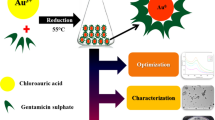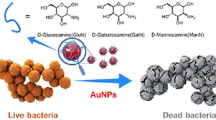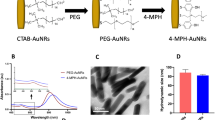Abstract
Gold nanoclusters protected with bovine serum albumin (AuNC) can be used in multiple biomedical applications through functionalization with two new and bioactive peptides. Both cationic peptides sequences of 17 amino acids in length and the cysteine residue at its C-terminus were designed and synthesized. Peptides were obtained by solid phase synthesis using the Fmoc strategy. Peptides may be coupled via disulfide bonds to AuNC with hydrodynamic size ~ 2 nm ± 0.3 determined by dynamic light scattering and it had a zeta potential value equal to − 42 mV. Peptides named NBC2253 and NBC2254 were attached to the AuNC using N-succinimidyl-3-(2-pyridyl-dithiol) propionate as crosslinker agent. AuNC@NBC2253 was more active against methicillin-resistant Staphylococcus aureus (MIC50 6.5 µM) and AuNC@NBC2254 exhibited higher antimicrobial activity than the free peptides on Escherichia coli O157:H7 (MIC50 3.5 µM). No hemolysis was detected for any of the peptides. It is evidenced that these antimicrobial peptides conjugated to AuNC serve as promising agents to combat some multi-resistant bacterial strains and that the specific binding of these antimicrobial peptides to gold nanoclusters improves the interaction of these nanostructured systems with the biological target.



Similar content being viewed by others
References
Vigderman L, Zubarev ER (2013) Therapeutic platforms based on gold nanoparticles and their covalent conjugates with drug molecules. Adv Drug Deliv Rev 65:663–676
Kogan MJ, Olmedo I, Hosta L, Guerrero AR, Cruz LJ, Albericio F (2007) Peptides and metallic nanoparticles for biomedical applications. Nanomedicine 2:287–306
Liu Y, Shipton MK, Ryan J, Kaufman ED, Franzen S, Feldheim DL (2007) Synthesis, stability, and cellular internalization of gold nanoparticles containing mixed peptide–poly(ethylene glycol) monolayers. Anal Chem 79:2221–2229
Brogden KA (2011) In: Drider D, Rebaffat S (eds) Perspectives and peptides of the next generation”, in Prokaryotic antimicrobial peptides: genes to applications. Springer, New York
Yount NY, Bayer AS, Xiong YQ (2006) Advances in antimicrobial peptide immunobiology 84:435–458
Markman JL, Rekechenetskiy A, Holler E, Ljubimova JY (2013) Nanomedicine therapeutic approaches to overcome cancer drug resistance. Adv Drug Deliv Rev 65:1866–1879
Brandelli A (2012) Nanostructures as promising tools for delivery of antimicrobial peptides. Mini Rev Med Chem 12:731–741
Narla SN, Pinnamaneni P, Nie H, Li Y, Sun XL (2014) BSA-boronic acid conjugate as lectin mimetics. Biochem Biophys Res Commun 443:562–567
Zhang M, Dang YQ, Liu TY, Li HW, Wu Y, Li Q, Wang K, Zou B (2013) Pressure-induced fluorescence enhancement of the BSA-protected gold nanoclusters and the corresponding conformational changes of protein. J Phys Chem 117:639–647
Ming X, Carver K, Wu L (2013) Albumin-based nanoconjugates for targeted delivery of therapeutic oligonucleotides. Biomaterials 34:7939–7949
Zhang L, Pornpattananangkul D, Hu CJ, Huang C (2010) Development of nanoparticles for antimicrobial drug delivery. Curr Med Chem 17:585–594
Ding H, Yang D, Zhao C, Song Z, Liu P, Wang Y, Chen Z, Shen J (2015) Protein-gold hybrid nanocubes for cell imaging and drug delivery. ACS Appl Mater Interfaces 7:4713–4719
Lin CAJ, Chuang WK, Huang ZY, Kang ST, Chang CY, Chen CT, Li JL, Li JK, Wang HH, Kung FC, Shen JL, Chan WH, Yeh CK, Yeh HI, Lai WFT, Chang WH (2012) Rapid transformation of protein-caged nanomaterials into microbubbles as bimodal imaging agents. ACS Nano 6:5111–5121
Prada YA, Guzmán F, Rondón R, Escobar P, Ortiz C, Sierra DA, Torres R, Mejía-Ospino E (2016) A new synthetic peptide with in vitro antibacterial potential against Escherichia coli O157: H7 and methicillin-resistant Staphylococcus aureus (MRSA). Probiotics Antimicrob Proteins 8:134–140
Jofré C, Guzmán F, Cárdenas C, Albericio F, Marshall SH (2011) A natural peptide and its variants derived from the processing of infectious pancreatic necrosis virus (IPNV) displaying enhanced antimicrobial activity: a novel alternative for the control of bacterial diseases. Peptides 32:852–858
Gopal R, Park JS, Seo CH, Park Y (2012) Applications of circular dichroism for structural analysis of gelatin and antimicrobial peptides. Int J Mol Sci 13:3229–3244
Xie J, Zheng Y, Ying JY (2009) Protein-directed synthesis of highly fluorescent gold nanoclusters. J Am Chem Soc 131:888–889
Yuan X, Luo Z, Zhang Q, Zhang X, Zheng Y, Lee JY, Xie J (2011) Synthesis of highly fluorescent metal (Ag, Au, Pt, and Cu) nanoclusters by electrostatically induced reversible phase transfer. ACS Nano 5:8800–8808
Ojeda N, Cárdenas C, Guzmán F, Marshall H (2016) Chemical synthesis and in vitro evaluation of a phage display derived peptide active against infectious salmon anemia virus. Appl Environ Microbiol 82:2563–2571
Cruz J, Ortiz C, Guzmán F, Torres R (2014) Antimicrobial peptides: promising compounds against pathogenic microorganisms. Curr Med Chem 21:2299–2321
Yahia-ammar A, Sierra D, Me F (2016) Self-assembled gold nanoclusters for bright fluorescence imaging and enhanced drug delivery. ACS Nano 10:2591–2599
Cao X, Li H, Lian L, Xu N, Lou D, Wu Y (2015) A dual-responsive fluorescence method for the detection of clenbuterol based on BSA-protected gold nanoclusters. Anal Chim Acta 871:43–50
Protein cross-linkers: handook & selection guide (2018) G-Biosciences, USA
Gaber M, Medhat W, Hany M, Saher N (2017) Protein-lipid nanohybrids as emerging platforms for drug and gene delivery: challenges and outcomes. J Control Release 254:75–91
An FF, Zhang XH (2017) Strategies for preparing albumin-based nanoparticles for multifunctional bioimaging and drug delivery. Theranostics 7:3667–3689
Gifford JL, Hunter HN, Vogel HJ (2005) Lactoferricin: a lactoferrin-derived peptide with antimicrobial, antiviral, antitumor and immunological properties. Cell Mol Life Sci 62:2588–2598
Muhle SA, Tam JP (2001) Design of Gram-negative selective antimicrobial peptides. Biochemistry 40:5777–5785
Kandasamy SK, Larson RG (2006) Effect of salt on the interactions of antimicrobial peptides with zwitterionic lipid bilayers. Biochim Biophys Acta—Biomembr 1758:1274–1284
Maupetit J, Derreumaux P, Tufféry P (2010) A fast method for large-scale de novo peptide and mini protein structure prediction. J Comput Chem 31:726–738
Bensch KW, Raida M, Mägert H-J, Schulz-Knappe P, Forssmann W-G (1995) hBD-1: a novel β-defensin from human plasma. FEBS Lett 368:331–335
Tam JP, Lu YA, Yang JL (2008) Correlations of cationic charges with salt sensitivity and microbial specificity of cystine-stabilized β-strand antimicrobial peptides. J Biol Chem 277:50450–50456
Yang L, Weiss TM, Lehrer RI, Huang HW (2000) Crystallization of antimicrobial pores in membranes: magainin and protegrin. Biophys J 79:2002–2009
Mosca D, Hurst MA, Beverly W, Fujii C, Falla T (2000) IB-367, a protegrin peptide with in vivo and in vivo activities against the microflora associated with oral mucositis. Antimicrob Agents Chemother 44:1803–1808
Antcheva N, Zelezetsky I, Tossi A (2006) Cationic antimicrobial peptides—the defensins. Handbook of biologically active peptides. Academic Press, Amsterdam, pp 5–67
Rodziewicz-motowidło S, Mickiewicz B, Greber K, Sikorska E (2010) Antimicrobial and conformational studies of the active and inactive analogs of the protegrin-1 peptide. FEBS J 5:1010–1022
Oudhoff MJ, Kroeze KL, Nazmi K, Van Den Keijbus PAM, Van Hof W, Fernandez-Borja M, Hordijk PL, Gibbs S, Bolscher JGM, Veerman ECI (2009) Structure-activity analysis of histatin, a potent wound healing peptide from human saliva: cyclization of histatin potentiates molar activity 1000-fold. FASEB J 23:3928–3935
Xu R, Fisher M, Juliano RL (2011) Targeted albumin-based nanoparticles for delivery of amphipathic drugs. Bioconjug Chem 22:870–878
Gu H, Ho PL, Tong E, Wang L, Xu B (2003) Presenting vancomycin on nanoparticles to enhance antimicrobial activities. Nano Lett 3:1261–1263
Lee E, Shin A, Jeong KW, Jin B, Jnawali HN, Shin S, Shin SY, Kim Y (2014) Role of phenylalanine and valine10 residues in the antimicrobial activity and cytotoxicity of piscidin-1. PLoS ONE 9(12):1–30
Acknowledgements
This work was funded by COLCIENCIAS through the Universidad Industrial de Santander under project 434-2011, and by the CINTROP research group performing the cytotoxic assays.
Author information
Authors and Affiliations
Corresponding author
Ethics declarations
Conflict of interest
We express our consent to the publication of results declaring no conflict of interest.
Additional information
Publisher's Note
Springer Nature remains neutral with regard to jurisdictional claims in published maps and institutional affiliations.
Electronic supplementary material
Below is the link to the electronic supplementary material.
Rights and permissions
About this article
Cite this article
Prada, Y.A., Guzmán, F., Ortíz, C. et al. New Synthetic Peptides Conjugated to Gold Nanoclusters: Antibiotic Activity Against Escherichia coli O157:H7 and Methicillin-Resistant Staphylococcus aureus (MRSA). Protein J 38, 506–514 (2019). https://doi.org/10.1007/s10930-019-09840-9
Published:
Issue Date:
DOI: https://doi.org/10.1007/s10930-019-09840-9




